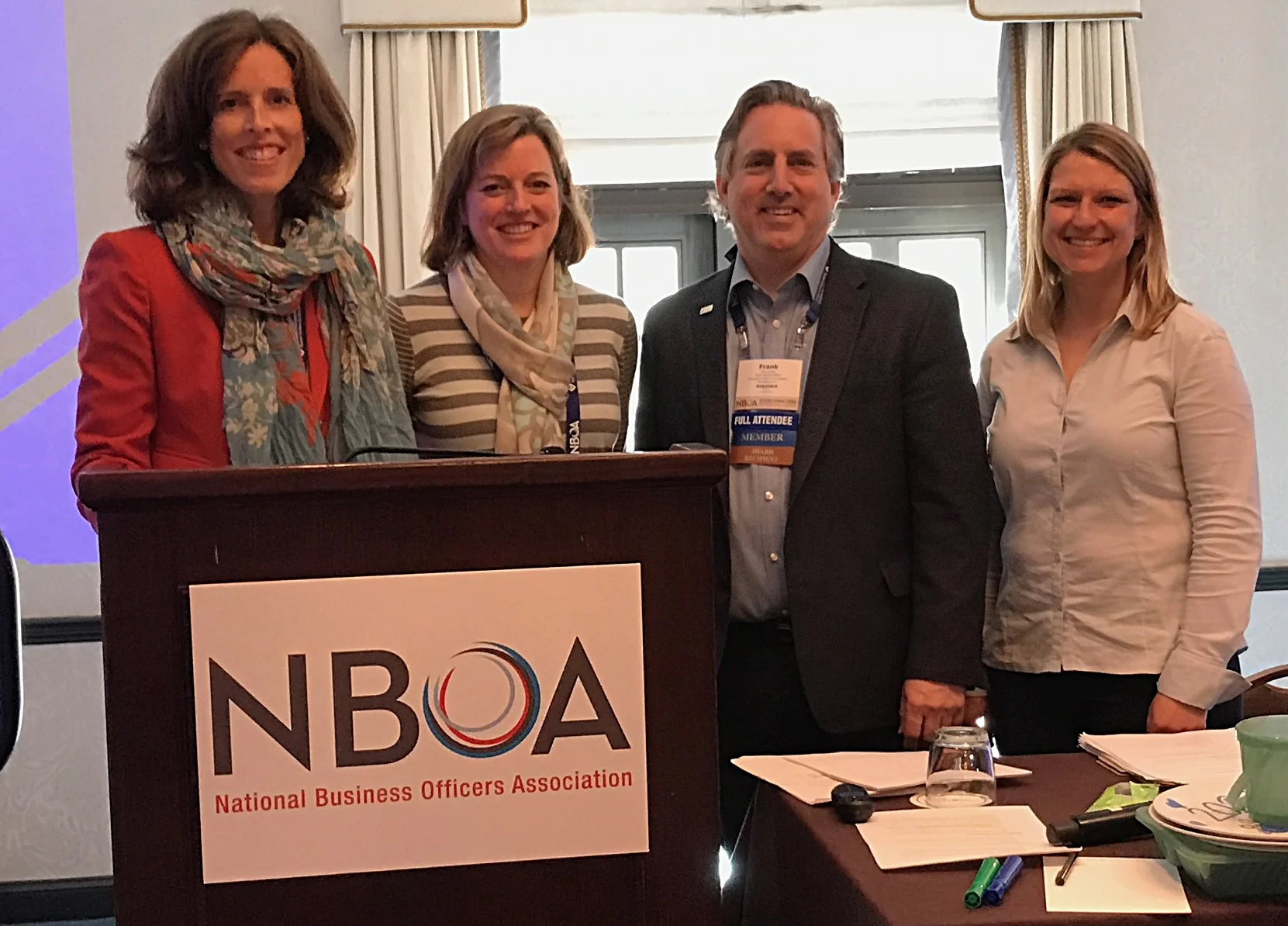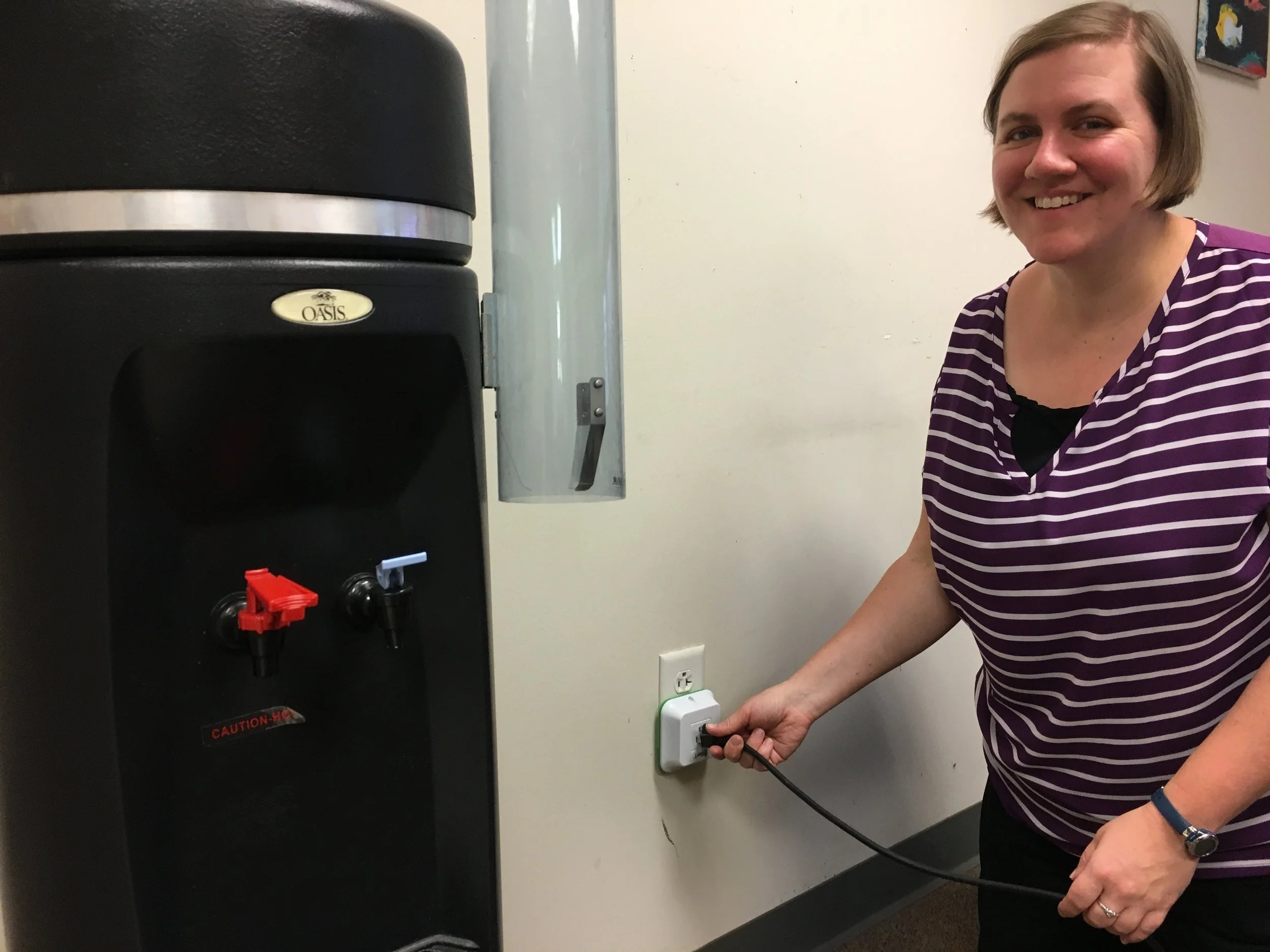Learn how one school is reducing its energy consumption looking at its "energy vampires."
Envirothon Teachers Learn about Eco-Schools USA Program
PAISBOA's Grant Inspires NFA to Reduce Waste
Norwood Fontbonne Academy's Collaborative Waste Initiative reduced school waste thanks to a grant from PAISBOA.
Transforming Schoolyard Habitats and Nature Play Spaces Offer Students More than Exercise
William Cramp Community School's new playspace.
This spring, Boyer Sudduth worked with PA Green and Healthy Schools Partnership (PAGHSP) on a series of educational webinars and workshops for school administrators, teachers, and staff focused on efforts to “green” schools. On April 6, 2017, PAGHSP featured a webinar called “Transforming Schoolyard Habitats and Nature Play Spaces,” which can be viewed below.
In the webinar, Director of Interpret Green & Neighborhood Nature Works in Philadelphia, Craig Johnson, and Sr Policy Advisor for the MD Dept of Natural Resources, Sandi Olek, share their expertise on creating wildlife habitats and nature play spaces for schoolyards, playgrounds, and parks. Sandi shows examples of innovative play environments built from natural elements. Craig illustrates excellent examples on how schools can enhance outdoor playspaces by adopting guidelines from National Wildlife Federation to create innovative “learning landscapes.” These landscapes can include pollinator gardens, bird feeders and houses, bug magnifier posts, sundials, compass roses, naturecams, and weather stations for environmental education and free-play exploration. Here, children can study nature and enjoy recreation in the same location. Craig and Sandi also shared a list of kid-friendly nature tools for observing and recording critters.
According to Craig, nature habitats help playspaces come alive. Craig’s work with Philadelphia’s William Cramp Community School gives students direct and daily access to the wondrous web-of-life. Birds, butterflies, bees, beetles, bats, and a host of native plants provide endless opportunities for children to connect with nature and each other. Craig notes, “Within two days of installing the bird feeders, mourning doves, sparrows, and finches were singing in schoolyard.” Another teacher reflects, “I have been here for 20 years. This is the first time I have ever seen birds at this school. The students are so delighted.”
In competition with television, phones, and video games, “unplugged” outside time is critical to a child’s playtime and development now more than ever. The American Academy of Pediatrics recommends 60 minutes of unstructured free play as an essential part of children’s physical and mental health and social development. Click here for a link to the webinar.
A William Cramp student in the school's new garden.
Article submitted by Emily Tronson, a junior majoring in Ecology & Evolutionary Biology and English Literature at the University of Rochester who is currently interning at Boyer Sudduth Environmental Consultants.
Area Schools' Sustainability Leaders Convene at EA
On April 26th, PAISBOA held its second meeting of the year, entitled “Journey to Sustainability: The Ebbs & Flows” at Episcopal Academy (EA) in Devon, PA. EA's Director of Operations, Mark Notaro, and Win Shafer, EA’s Science Teacher and future Sustainability Coordinator, led the group of 18 members from eight area schools and sustainable business managers on a tour of EA’s Doolittle Greenhouse, community garden, chemical-free landscape, green roof, and on-site industrial sized composter.
After the tour, the group enjoyed a sustainably sourced dinner followed by a discussion facilitated by Mary Ann Boyer, co-founder and principal of Boyer Sudduth Environmental Consultants. The conversation focused around strategies that will help school representatives and business leaders be mindful and proactive when planning future meetings. Members also had the opportunity to network and share stories of their journey to sustainability.
Participant Roderick Wolfson of St. James School reflected, “I appreciated seeing the recent construction around campus and the candid presentation from Mark about what works and what doesn’t.”
The PAISBOA Sustainability Group will reconvene in the fall and continue its mission to share information among the group of engaged, insightful and highly motivated individuals to improve our schools, communities and environment. For more information about future meetings, contact Mary Ann Boyer at maboyer61@gmail.com or Al Greenough at agreenough@paisboa.org.
Written by: MaryKate O'Brien, intern at Boyer Sudduth Environmental Consultants. Published in the PAISBOA Friday Flyer on May 5th. Read the flyer HERE.
Group members explore EA's community garden and discuss maintenance strategies for sustainability initiatives on campus.
How To Fund your Green Project
Thinking about bringing extra money to your school? Here are six tips to get you started on your grant writing venture!
1. Know Your Audience
Get to know your funder’s mission and purpose of the grant. Don’t be afraid to “toot your own horn” about your past accomplishments. Highlight how your project will align with the funder’s mission. It never hurts to set up a face-to-face meeting or a phone call to learn more about the grant opportunity. This gives the funder a chance to get to know you better. Take time to research about past grant recipients to gauge whether you would be a strong match.
2. Can the Project Be Sustained?
Awarding a grant is a type of financial investment to promote the funder’s mission and goals. Therefore, funders want to make sure they are supporting a “sustainable” organization that will continue on even after the grant has been used.
Demonstrate that you are proactive in securing other funds and resources:
List grants you have applied, even if you were not selected
If possible, match the grant - whether it’s through another grant, fundraising, or donations
Community support will help your organization withstand difficulties and thrive. This includes but is not limited to:
Partner organizations
Volunteers and their skills and expertise
3. Details, Details, Details
Be as specific as you can about how you are going to spend the grant money.
Poor example: “The funds will be used to purchase materials we need for composting leftover food from the dining hall.”
Better: “The funds will be used to purchase a composter and to print and laminate signage about composting designed by students.”
Even Better: An easy to read, itemized chart. Bulleted description and photo of each item may be helpful as well.
4. Be Concise
While it is important to be specific, it is just as important to make your application easy to read and process. The grant reviewer will be reading a number of other applications and unnecessary language or “fluff” takes away from the clarity of your project.
Use bullets, charts, lists
Include images: pictures are worth 1,000 words when used right
Make every word count
5. Don’t Be Afraid To Be Different
The history or specific needs of your community can set your application apart from others. Need is more than just economics - it can also include access to resources, health disparities and social justice. Your application becomes stronger and more convincing when you demonstrate how the grant will address the unique needs of your community.
6. Be Enthusiastic
Don’t be afraid to show enthusiasm for your project. It is reassuring for the funders to know that their grant award will be appreciated and spent responsibly.
Here is an on-going grant to check out: Donors Choose. This organization connects your classroom to a community of donors who fund classroom projects.
No grant is too small to help your idea grow into a successful project!
Written by Grace Yi, a Nature Preschool Teacher at Schuylkill Center for Environmental Education and intern at Boyer Sudduth Environmental Consultants
Resources Used:
How to Apply for Grants: 1-2. KidsGardening, 2016. Print.
School Garden Grant Writing Suggestions: 1-7. Whole Kids Foundation, 1 June 2014. Web.
Picture: Nonprofit News: Grant-writing Survival Tips for Counselors. Web.
A Composter Bin: The Newest Member of NFA Dining Hall
Norwood-Fontbonne Academy (NFA) received a Weavers Way Green Community Projects grant in March 2017. This grant supports a larger initiative to reduce waste, increase recycling and composting, and teach students to minimize their impact on earth. With grant funds, NFA will purchase a new composter that can hold up to 267 gallons of food and yard waste. According to NFA’s chef Annie Bercaw, “We are excited to significantly reduce NFA’s waste production and divert our compostable garbage using this new composter.” Adds Mrs. Nancy Peluso, the Director of Lower Grades, "We are thrilled to receive the Weavers Way Grant as it provides hands-on learning opportunities and supports our commitment to environmental sustainability.”
Published in the Chestnut Hill Local on April 20, 2017, Page 11. Written by Grace Yi, a Nature Preschool Teacher at Schulykill Center for Environmental Education and intern at Boyer Sudduth Environmental Consultants.
Annie Bercaw of Apple Annie's Catering shows the food waste scraps that can be composted.
Taking a Bite Out of Waste
Not Your Grandmother's Gingerbread House
What do you get when you pair a future environmental engineer, an aspiring architect, some gingerbread and frosting? Not your grandmother's gingerbread house, but a sustainable one. Mary Ann Boyer met with Hill School students in the Eco Action Club to conduct a workshop on green buildings. Students incorporated lessons learned by building "green" gingerbread houses.
AFS Outside Committee Considers Next Projects
Take a Hike--With a Child
According to Richard Louv, advocate for connecting children and their families to nature and author of Last Child in the Woods (2008), “Today, average eight-year-olds are better able to identify cartoon characters than native species, such as beetles and oak trees, in their own community.” Louv has done extensive research on how children’s mental, physical, and spiritual health are directly linked to our relationship with nature (Louv, 2008). Just as children need sufficient sleep every night, they also require significant exposure to nature.
NFA Wins Grant for Sustainability
Norwood-Fontbonne Academy received a grant from the Philadelphia Area Independent Schools Business Officers Association to address environmental sustainability and foster collaboration between the school and neighboring institutions.
NFA teamed up with its Parents Association, Chestnut Hill College, Morris Arboretum, and Boyer Sudduth Environmental Consultants to create a Collaborative Waste Initiative to reduce waste, increase recycling, and strengthen community ties.
Compost 101: Ancillae-Assumpta Academy Does it Right
Ancillae-Assumpta Academy composts all of its dining room waste with support from their students and faculty. Ancillae-Assumpta’s green initiatives include solar panels, school gardens, outdoor education, to name a few. However, the school decided to do even more. Boyer Sudduth Environmental Consultants lead facilitated meetings with the faculty and administration to identify sustainability goals. Food Service Coordinator Sarah Wade took on composting all food waste generated by students and staff.
Lower School Girls are Zero Waste Heroes
In 2012, the SCH Academy lower school for girls identified a problem: food waste and recyclables were too often getting tossed into the large grey trash bins in the cafeteria instead of being thoughtfully separated into the compost bucket and blue recycling bins. With support from the science teachers and faculty sustainability committee, the 2nd and 3rd grade students began a “design thinking” process to identify the specific problems with cafeteria waste and to brainstorm solutions.
Why Compost?
Red Clay Schools Lead the Nation in Energy Savings
Gardens, Water, & Food: The Hill School’s Sustainability Trifecta
PAISBOA Members Learn About Reducing Cafeteria Waste
On April 27, 2016 PAISBOA's Sustainability Affinity Group gathered to hear how to "Reduce your Environmental Footprint: One Bite at a Time" at Springside Chestnut Hill Academy (SCH). Sustainability consultants Mary Ann Boyer and Anne Sudduth of Boyer Sudduth Environmental Consultants and SCH science teachers, Marianne Maloy and Carie Szalay, used SCH's zero waste initiative as a case study.
Wendy Turner: It Takes a Village to Be Green
How much of a difference can one teacher make? When it comes to environmental sustainability, Wendy Turner, a second grade teacher at Mt. Pleasant Elementary School, shows that one teacher can inspire the “greening” of a whole school. Turner’s leadership sparked enthusiastic support and hard work from her peers, students, parents and the school’s administration.





















